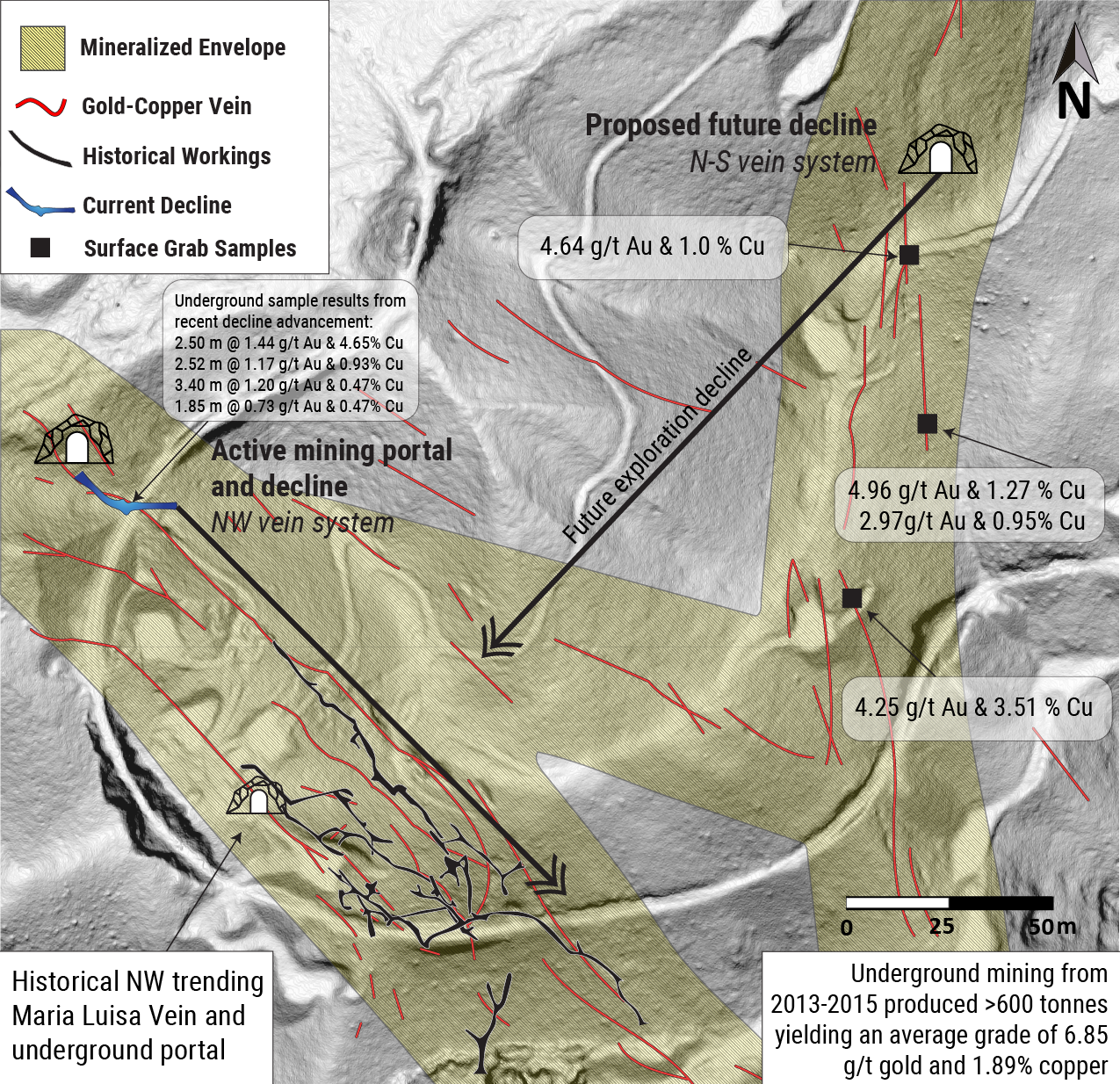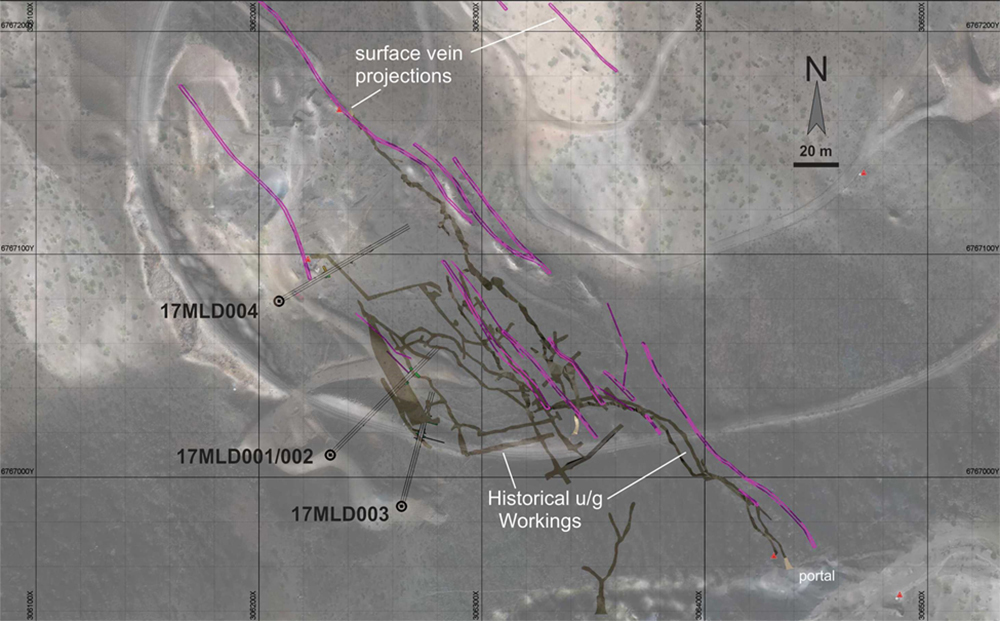Overview
MARIA LUISA
INCAHUASI, CHILE
The Maria Luisa gold-copper project is located approximately 100 km north of La Serena, within the Atacama Region of Chile where Mid-Cretaceous mountain-building and transtensional tectonism produced the north-south trending Atacama Fault System (AFS). The AFS is the regional structural control on hydrothermal gold-copper vein deposits in the La Serena region.
At Maria Luisa, northwest-southeast and north-south trending faults host the gold-copper mineralization. The mineralized NW-SE faults are extensional features developed during the sinistral N-S movement of the AFS. Gold/copper-bearing veins at Maria Luisa form in these extensional zones because they provide excellent pathways for gold-laden fluids. There remain abundant NW structures to be investigated on the property, providing significant growth potential at Maria Luisa.
Mineralization
The Maria Luisa project consists of moderate to steeply dipping, NW-SE, and N-S gold-copper-bearing veins. The veins measure 1-3 m in diameter with strike lengths of up to 1 km. The granitic and volcanic host rocks on the property are heavily chloritized (propylitic alteration). Historical mining was focused on the NW-trending Maria Luisa vein, a structure that is traceable on the surface for ~500 m with widths from 1-5 metres. Mineralization occurs as gold-copper(+/-iron) oxides with pyrite, chalcopyrite, and bornite.
Mineralization is thought to have been emplaced in two different stages:
- Au-rich mineralization consists of specular hematite-quartz banded veins with epithermal textures that include open spaces, crustiform quartz, and bladed calcite indicative of boiling. A 1.6 m sample was taken from a massive hematite vein and assayed up to 25 g/t Au, suggesting an association between Au and hematite. The presence of jarosite provides an additional potential for a zone of supergene Au-Cu enrichment.
- Cu-rich mineralization consists of magmatic-hydrothermal breccia with abundant angular fragments of stage one mineralization, with andesitic rock either clast supported or cemented by siderite and iron-copper oxides.
Diamond Drilling
As part of the ongoing decline development and exploration work, an underground drill program is underway to delineate the gold-copper vein systems at depth and guide future development. A series of short holes are being drilled to support the current decline and future expansion. In addition, drilling is better defining N-S vein sets, which were poorly understood historically and not mined, however, appear to have significant upside.
Historical Resource and Exploration Target
The Maria Luisa veins have consistently yielded significant gold grades, with recent selective mining (2013 to 2015) of over 600 tonnes producing an average grade of approximately 6.85 grams per tonne (g/t) Au and 1.89 percent (%) Cu (M. Dufresne, NI 43-101 Technical Report, February 2017). An exploration target for the Maria Luisa project has been developed based on the historical resource estimate conducted by ENAMI, historical production records, recent underground mapping and sampling, and 3D modelling. The target ranges from 200,000 to 400,000 tonnes with a range in grades of 1.5% Cu and 2 g/t Au to 2.5% Cu and 5 g/t Au.
Development Plan
Altiplano is developing a fast-tracked exploration and development plan designed to facilitate mine planning and provide the basic mining infrastructure for near-term extraction**. Altiplano received an exploitation permit for the is work in September of 2021 and began the underground decline development in November 2021.
The mining activity is designed to reach high-grade gold-copper veins through multiple access points on a decline system. The decline enters at the property's southwest corner and targets the mineralized zone with historical average grades of 6.85 g/t Au and 1.89 % Cu.
The northwest and southeast mineralized Au-Cu veins will be accessed through crosscuts on 4 separate levels and designed to create up to 8 mining faces (Figure 6.). The underground work will provide detailed geological knowledge and generate the opportunity to extract Au-Cu mineralized bulk samples that can be sold to nearby processing plants to offset some of the development costs in advance of a full ramp up.
The company plans to initially extract up to 3,000 tonnes of mineralized gold-copper material in Phase I with future opportunity to expand to 5,000 tonnes. The construction time after permitting approval is expected to be approximately 6 months. The process of review and granting of the permit is anticipated to take approximately two months. Once the approval has been granted the company is funded to immediately begin the construction of the decline.
* This estimation of quantity and grade is conceptual with insufficient work to define a mineral resource. The issuer is not treating the historical estimates as current mineral resources or mineral reserves, and further exploration may or may not define a resource at Maria Luisa (M. Dufresne, NI 43-101 Technical Report, February 2017).
** A decision to commence underground operations at the Maria Luisa site is not based on a feasibility study of mineral reserves demonstrating economic and technical viability and there is increased uncertainty and economic and technical risks of failure associated with this decision.



